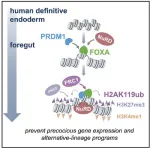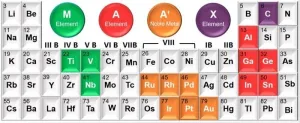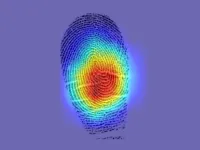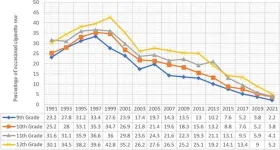(Press-News.org) One of the important breakthroughs that made it possible to program or reprogram cell fate more efficiently and with higher fidelity in a dish was discovering how to make use of a small set of molecular cowboys called pioneer transcription factors (TFs).
Every cell in our bodies has more than 200 transcription factors expressed inside, riding along the DNA helix instructing specific genes to activate and deactivate. During the early stages of fetal development, a small subset of “pioneer” TFs act inside our precursor cells driving them to make the mature cells that become parts of the spine, the heart, the liver, and so on.
Identifying the key pluripotent pioneer TFs helped researchers learn how to make induced pluripotent stem cells from any type of adult cells, which could then be instructed to make other types of cells, thus forming organoids that can mimic functional organ tissue. Furthermore, tissue-specific pioneer TFs can directly reprogram one adult cell type into a targeted cell type without passing through a pluripotent state.
Currently, there is considerable interest in producing therapeutic target cells from pioneer TF-mediated reprogramming of skin or other accessible somatic cells, as they hold great promise for personalized disease modeling and regenerative medicine. However, a major challenge is achieving sufficient gene repression of the original cell type, as inadequate repression often leads to the formation of “dead-end” cells or hybrid cells, thus limiting translational applications.
Now a study published online Jan. 10, 2024, in Molecular Cell, reveals important new details about how pioneer TFs do their important jobs.
“As we gain a more comprehensive understanding of the mechanisms underlying pioneer TF-mediated gene repression, it will greatly enhance the precise manipulation of cell fate in cellular programming and reprogramming,” says Makiko Iwafuchi, PhD, a member of the Division of Developmental Biology and the Center for Stem Cell & Organoid Medicine at Cincinnati Children’s.
The first author, Satoshi Matsui, PhD, and Iwafuchi collaborated with Hee-Woong Lim, PhD, a co-senior author and a member of the Division of Biomedical Informatics, on the study.
Until this study, most experts believed that pioneer TFs functioned primarily by activating genes to send cells toward their ultimate fates. However, scientists have learned that our genetic programming is packed with alternative pathways, which must be actively shut down.
So how does the body ensure that precursor cells consistently follow the correct path? It turns out that pioneer TFs do more than push cells in the desired direction. When functioning correctly, these cowboys ride ahead and cut off alternative paths so that developing cells keep developing as intended.
Who are these pioneers?
The Cincinnati Children’s team established a new CRISPR interference (CRISPRi) model to explore how the pioneer transcription factor FOXA controls human endoderm differentiation during liver development, and how the pioneer transcription factor OCT4 influences the behavior of pluripotent stem cells.
They found that when FOXA function was disrupted, cells followed multiple development pathways. But when FOXA functioned normally, the cells stayed on track. This allowed the team to conclude that FOXA prevents alternative lineage and precocious gene expression.
The team went on to show that FOXA gets help with repressing access to alternative pathways from another transcription factor called PRDM1 and other epigenetic repressors. Meanwhile in pluripotent cells, the pioneer transcription factor OCT4 performs a similar repression function by teaming up with a related transcription factor called PRDM14.
The central role of FOXA and its ability to repress development pathways were unexpected and critical findings that could influence future organoid and cell reprogramming studies, Iwafuchi says.
Finding a similar relationship occurring with OCT4 was an important further proof of concept because that transcription factor was already known to be among the pioneer TFs that enable reprogramming of somatic cells into pluripotent stem cells.
Next steps
Now that researchers have shown that two pioneer TFs coordinate with PRDM TFs to safeguard cell fate, it appears likely that other TFs have similar relationships. As these TF teams are identified, it may become possible to produce organoids and other engineered tissues in larger volumes with higher degrees of consistency and fidelity—steps that will be important for scaling up the technology.
About the study
In addition to Matsui, Iwafuchi, and Lim, Cincinnati Children’s co-authors included Marissa Granitto, Morgan Buckley, Katie Ludwig, Sandra Koigi, and Joseph Shiley, and Christopher Mayhew, all with the Division of Developmental Biology; and William Zacharias, Division of Pulmonary Biology.
Funding sources for this study include the National Institutes of Health (1R01GM143161), the Digestive Health Center (P30 DK078392), the Japan Society for the Promotion of Science Foundation, the Uehara Memorial Foundation, and the Cincinnati Children’s Research Foundation (Trustee Awards and Center for Pediatric Genomics Pilot Awards).
END
How ‘pioneers’ blaze the one trail that determines cell fate
Scientists at Cincinnati Children’s shed light on how a special set of transcription factors ride herd on developing organs, not just by pointing cells to their proper place, but also by cutting off other ways of getting there
2024-01-10
ELSE PRESS RELEASES FROM THIS DATE:
General A-site alloying strategy helps to prepare noble metal-occupied MAX phases
2024-01-10
Researchers led by Prof. HUANG Qing from the Ningbo Institute of Materials Technology and Engineering (NIMTE) of the Chinese Academy of Sciences, in collaboration with researchers from the Zhejiang Institute of Tianjin University, and Linköping University, Sweden, has proposed a general A-site alloying strategy for the preparation of noble metal-occupied MAX phases.
This work was published in Matter.
MAX phases are a family of ternary layered transition metal carbides that have attracted great attention ...
Architectures, opportunities, and challenges of Internet-of-batteries for electric Vehicles
2024-01-10
A paper describing the architectures, opportunities, and challenges of the IoB was published in the journal Green Energy and Intelligent Transportation on September 7th, 2023.
The present battery technology employed in electric vehicles (EVs) faces several critical challenges. Firstly, the limited operation range of EVs remains a major concern for potential users, as it affects their ability to travel long distances without the need for frequent recharging. Additionally, long charging times are inconvenient ...
Observing macroscopic quantum effects in the dark
2024-01-10
The boundary between everyday reality and the quantum world remains unclear. The more massive an object, the more localized it becomes when being made quantum through cooling down its motion to the absolute zero. Researchers, led by Oriol Romero-Isart from the Institute for Quantum Optics and Quantum Information (IQOQI) of the Austrian Academy of Sciences (ÖAW) and the Department of Theoretical Physics at the University of Innsbruck, propose an experiment in which an optically levitated nanoparticle, cooled to its ground state, evolves in a non-optical (“dark”) potential created by electrostatic or magnetic forces. This evolution in the dark potential ...
AI discovers that not every fingerprint is unique
2024-01-10
Columbia engineers have built a new AI that shatters a long-held belief in forensics–that fingerprints from different fingers of the same person are unique. It turns out they are similar, only we’ve been comparing fingerprints the wrong way!
New York, NY—January 12, 2024—From “Law and Order” to “CSI,” not to mention real life, investigators have used fingerprints as the gold standard for linking criminals to a crime. But if a perpetrator leaves prints from different fingers in two different crime scenes, these scenes are very difficult to link, and the trace can go ...
JMIR Mental Health accepted for MEDLINE indexing
2024-01-10
JMIR Publications is pleased to announce that JMIR Mental Health (JMH) has been accepted for inclusion in MEDLINE, which is the U.S. National Library of Medicine's premier bibliographic database.
JMIR Mental Health had already been indexed in PubMed previously. MEDLINE is a more selective subset of PubMed, consisting of the top 5,200 biomedical journals. Indexing in MEDLINE also means that articles are now also indexed with NLM Medical Subject Headings (MeSH terms) and other metadata.
Selection for MEDLINE is a result of a thorough review of the ...
Reduced drug use is a meaningful treatment outcome for people with stimulant use disorders
2024-01-10
Reducing stimulant use was associated with significant improvement in measures of health and recovery among people with stimulant use disorder, even if they did not achieve total abstinence. This finding is according to an analysis of data from 13 randomized clinical trials of treatments for stimulant use disorders involving methamphetamine and cocaine. Historically, total abstinence has been the standard goal of treatment for substance use disorders, however, these findings support the growing recognition that a more nuanced perspective on measuring treatment success may be beneficial.
The study, published in Addiction, was led by scientists at the Johns Hopkins Bloomberg School of Public ...
Blood test distinguishes neuroendocrine subtype of advanced prostate cancer
2024-01-10
Boston – Like a criminal entering a witness protection program, cancer cells can shed their past and take on a new identity. Detecting such an identity-switch is particularly challenging when metastatic castration-resistant prostate cancer (CRPC) advances from adenocarcinoma to neuroendocrine prostate cancer (NEPC), a very difficult cancer to treat.
Now, however, researchers at Dana-Farber Cancer Institute and the University of Trento, Italy, have developed a blood test, described in Cancer Discovery, that can ...
Dramatic decline in cigarette use among U.S. teens over three decades
2024-01-10
Cigarette smoking remains the leading avoidable cause of premature death in the United States, accounting for approximately 500,000 deaths or 1 in 5 deaths annually. According to the U.S. Department of Health and Human Services, most adults who smoke cigarettes started before age 18, so preventing cigarette smoking in adolescents is important to reducing smoking in adults.
In a new study, researchers from Florida Atlantic University’s Schmidt College of Medicine and collaborators explored overall trends in cigarette smoking among a large sample of U.S. adolescents in grades nine to 12 from 1991 to 2021. They ...
Finding a home for the wandering mushrooms —— Phylogenetic and taxonomic updates of Agaricales
2024-01-10
Many edible, medicinal, and poisonous mushrooms that we are familiar with belong to the order Agaricales, which is a group of fungi with important economic and ecological value. Understanding the phylogenetic relationships of Agaricales can help us to know their evolutionary history and diversity, as well as their interactions with other organisms. Moreover, the phylogenetic framework of Agaricales can provide a basis for conserving biodiversity, such as measuring phylogenetic diversity and assessing the uniqueness and importance of different species.
Previous studies divided Agaricales into 8 suborders and 46 families, but the systematic position and phylogenetic relationship ...
ALS: blocking inflammation to reduce symptoms
2024-01-10
Québec, January 10, 2024 – In people with amyotrophic lateral sclerosis (ALS), changes in neurons appear to activate immune cells. Lowering the inflammation could reduce the symptoms of the disease, according to a study led by Chantelle Sephton, a professor at Université Laval's Faculty of Medicine.
ALS is caused by the loss of upper motor neurons, located in the brain, and lower motor neurons, which extend from the spinal cord to the muscles. Using a genetically modified mouse ...
LAST 30 PRESS RELEASES:
Electrodes created using light
Second-hand gift-giving is a well-deliberated decision
How human interaction drove evolution to make bears less aggressive
National Poll: Few parents offer teens guidance on healthy eating during holiday season
Cannabis derivatives could provide new ovarian cancer treatments
Raising strong yeast as a petroleum substitute
Clues to the origin of hot Jupiters hidden in their orbits
Canada’s reduced pledge to Global Fund will impact domestic health
1 in 4 children with major traumatic injuries not cared for in pediatric trauma centres
Duke and Duke-NUS’ joint cross-population research to uncover "East-West" differences in disease and care
Scientists to ‘spy’ on cancer- immune cell interactions using quantum technology breakthrough
Tech savvy users have most digital concerns
Making lighter work of calculating fluid and heat flow
Normalizing blood sugar can halve heart attack risk
Lowering blood sugar cuts heart attack risk in people with prediabetes
Study links genetic variants to risk of blinding eye disease in premature infants
Non-opioid ‘pain sponge’ therapy halts cartilage degeneration and relieves chronic pain
AI can pick up cultural values by mimicking how kids learn
China’s ecological redlines offer fast track to 30 x 30 global conservation goal
Invisible indoor threats: emerging household contaminants and their growing risks to human health
Adding antibody treatment to chemo boosts outcomes for children with rare cancer
Germline pathogenic variants among women without a history of breast cancer
Tanning beds triple melanoma risk, potentially causing broad DNA damage
Unique bond identified as key to viral infection speed
Indoor tanning makes youthful skin much older on a genetic level
Mouse model sheds new light on the causes and potential solutions to human GI problems linked to muscular dystrophy
The Journal of Nuclear Medicine ahead-of-print tip sheet: December 12, 2025
Smarter tools for peering into the microscopic world
Applications open for funding to conduct research in the Kinsey Institute archives
Global measure underestimates the severity of food insecurity
[Press-News.org] How ‘pioneers’ blaze the one trail that determines cell fateScientists at Cincinnati Children’s shed light on how a special set of transcription factors ride herd on developing organs, not just by pointing cells to their proper place, but also by cutting off other ways of getting there







